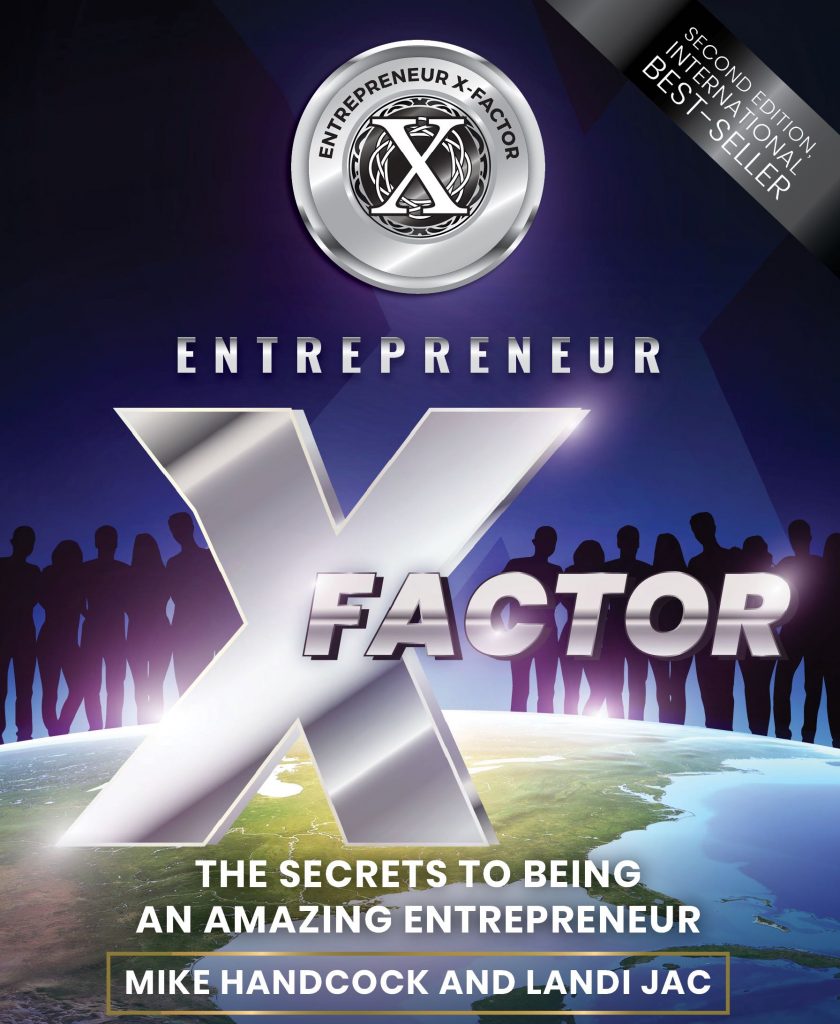This article by Rob Robertson is a chapter published in the Entrepreneur X-Factor Book, sharing three important X-Factor Leadership ingredients.
I still clearly recall the huge shock I got, and the emotion I felt on 31 January 2002. It was a group meditation exercise on a retreat in the Blue Mountains, near Sydney, Australia. The background is that after 13 years of being “Mr Positive” and being relatively successful, I thought I had life mostly sorted. Yet my view on life was about to change forever!
It was my turn to speak and to share in this safe space, and I was prompted to close my eyes and tune in. I then got what still feels like the biggest shock of my life. I had a huge eruption of anger which seemed totally out of character, certainly not what I expected. As I shared how I felt, big blocks of suppressed feelings came out. This was very much out of character for me, as on reflection I’d created this positive facade which was a total escape from reality, using the principles of positive thinking.
I felt scared and vulnerable as this new layer of anger was uncovered. I was not who I thought I was and that was disturbing on so many levels. This discovery was like a beast that had been hidden for a long time, dating back to when, as a 17-year-old, I left home to live at the halls of residence at Lincoln University. There, I experienced anxiety and depression as I tried to make the step into being an adult living away from home. After those struggles, and significant mental health battles, I got very excited a year later when I discovered the power of positive thinking. For many years I turned any negative thoughts into positives, which on reflection was a myopic, self-constructed, very limited view of reality. I had good self-esteem in the headspace, yet not at an emotional level. It was easy and safe to use positive thinking to hide my self-doubt, yet the reality was that this was a facade, and ultimately not sustainable.
This was the start of my Emotional Fitness journey. Driven by this discovery of the many big layers of self-doubt, emotional confusion, and low self-esteem. That retreat in 2002 was the start of this quest to learn all I could about emotions and the tools to integrate and own negative emotions. The outcome today is a powerful set of Emotional Fitness tools to grow self-belief, inner trust, and synchronicity. It’s an approach built on understanding and respecting my emotions and inner guidance.
The best illustration of these outcomes is in sport. With many years of learning, and trying different techniques to release the mental frailties and self doubt that surface under pressure to sabotage my performance. I’ve now experienced both sides of the mental skills divide. That journey has become the best education I could ever buy. Teaching me the tools to create a wonderful new mental toughness and realism that carries me to not only perform better in sport and business, but makes life vastly more enjoyable.

The Trust Journey
The headspace, a safe place I used to stay in control, is governed by finite boundaries and logic. It’s a place where we judge our value by comparing and evaluating at a logical level. Yet the real power is beyond the head and thoughts, to feel and sense in the heart. Rather than relying on logic, we can go beyond the head and thoughts to access the power of trusting our emotions, to empower our sixth sense, our heart, and also our gut-feel, to guide us.
While it sounds like a cliche, the true source of passion and fulfillment in life is found by following our heart. To understand and embrace what excites us.
Many things influence our decision making. While logic can be an important aspect of any decision, it’s important to be aware of whether a choice is driven by passion and inner desires, or from external opinions that exert pressures we feel we should live up to, say from our family, society or religion. Yet, to fully create a more fulfiling life is to understand our inner drivers and to connect with our emotions, as passion is the most sustainable form of motivation.
We are all born with different and unique skills. A truly successful life is driven by our individual passion, rather than meeting the needs of external people, which is often subject to fear or negative motivators. True joy, fulfillment, and passion can never be conceived in the head yet I was this very logical person, who had zero vulnerability because I could only recognise and accept positive outcomes. I disowned negative weaknesses because based only on logic, my limited spectrum was to judge things as good and bad. No middle ground, I had a very limited perspective of reality.
Today life is very different. I can reflect on what it was like to be in the headspace of positivity where a negative was turned into a positive. This was unrealistic, a facade.
In sport, there is no hiding when the physical body, the head, and heart are not aligned. Yet in business, I found I could fake positivity to a certain degree. I was National Sales Manager in a leading Australian ISP, responsible for more than 50 staff and team leaders, but it was all a game. Back then I had significant self-doubt, but I turned everything into a positive and just got on with it. I had a reasonable level of success in business, even if my mind, body, and heart were not really aligned. Yet on the tennis court, I could not hide and the misalignment of head and heart showed up constantly, like a festering sore needing treatment. Under pressure, I would fall apart, or I would have self-doubt that was sabotaging me during a match.
Along my journey, I studied sport psychology and became qualified as an Executive Coach. Working with business owners and sportspeople enabled me to develop a model and test the principles that had helped me gain greater inner trust. Initially, the model was to explain sports performance and the connection between head, heart, and body, including how the unconscious works to support or sabotage the flow between head and heart. This model is known as the “Inner Trust Engine” which explains how our connection between head and heart builds trust in all areas of life and business, well beyond the initial focus on sport.
We all have times of disconnection when things don’t flow and we become frantic. Yet, when there is a real trust between the head, heart, and the physical body, we have much higher output, trust, and flow from our “Inner Trust Engine.” This is the powerful X-factor ingredient that’s understood and used by top sports and business people.
The following are three important X-Factor Leadership ingredients in business.
1. X-Factor Trust
Many books have been written by business leaders explaining that their X-Factor is their gut-feel or intuitive decision making. They fully trust their instincts. This has been a powerful growth area for me as founder and CEO of Unboxed Performance. I am driven by the positive impact business can have on people’s lives when ethical, purpose-driven team cultures can be such a powerful force of good in the community. This is why I developed the “Team Trust Engine” as a model to explain how trust, technology, and individual behaviours collectively create a culture to get vastly more done.
Just as high levels of inner trust are essential for individuals, so too do teams perform better when the trust within the team is built on a culture of purpose and alignment. Only then can the team members gain higher levels of individual satisfaction, fulfillment, and ultimately performance, to get more done.
2. X-Factor Authenticity
Today, the new style of leadership is about listening and connecting with our team as real people. If we are authentic and real then people are more likely to trust us. This is even more powerful when we admit vulnerability and confess that we, as the leader, do not know all the answers.
Asking people for their opinion is a way of building a co-operative culture of greater trust. It helps to build trust in the leader, who shows they are genuine and open, totally real, and value the opinions of the team. Vulnerability does not require a leader to be over the top, emotional, or share deep, dark secrets. It does require them to be secure enough within themselves to ask for help when they need it. The leader needs to embrace the unknown, have the confidence to invite the team to contribute, be real and authentic, and avoid any facade of being all-knowing or untouchable.
3. X-Factor Listening
Listening builds trust and great leaders understand their team, and know-how to empower others to contribute. Right at the core of this culture is ensuring that people feel valued. This skill is listening, not lecturing. A powerful example of this is that children feel loved when their parents listen to them. Adults are the same, we feel appreciated and valued if a leader seeks to listen and understand us.
The old style of leadership is command and correct, yelling advice about what needs to be improved. Often this is a style they copied from previous leaders. But research suggests that a good relationship, in both marriage and leadership, is based on a 5 to 1 ratio of positive to negative communication. This means recognising 5 positive behaviours to 1 corrective or negative piece of feedback. This requires a leader to listen and identify specifics, not just general things that are going well.
To be effective, leadership feedback should be about specific behaviours and, where possible, a measurable aspect of their role. For example, rather than giving general feedback by saying “you’re doing a great job with your client communication,” more specific feedback might be “you’re doing a great job in listening to the client’s core needs and entering it into the customer database so we can all understand customers better.” The second example is specific about the behaviour so your team member is likely to associate positive feedback with their action. When feedback is too generic, it can come across as fluffy, inauthentic, and is likely to miss the point.

